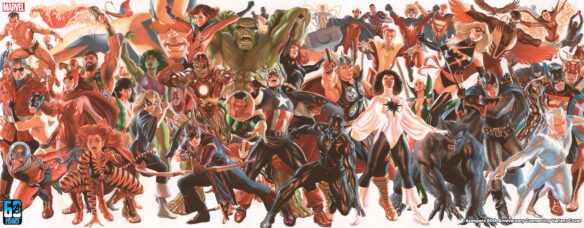(1) NATIONAL BOOK CRITICS. There seem to be only a couple works of genre interest among the 2025 National Book Critics Circle Finalists. Put the lists under your microscope, maybe you’ll find some more.

Fiction
- Beautyland by Marie-Helene Bertino (Farrar, Straus and Giroux)
The triumphant latest from Bertino (Parakeet) offers a wryly comic critique of social conventions from the perspective of a woman who also happens to be an alien from another planet. Adina, born in 1977 Philadelphia to an indefatigable and supportive “Earth mother,” is “activated” at age four by her extraterrestrial “superiors.” Her mission is to “report on the human experience” to her bosses on Planet Cricket Rice. They teach her to read and write in English before she starts school, and in one of her early communiques, she expresses a precocious insight into adult psychology after a store clerk is rude to her mother (“Human beings don’t like when other humans seem happy”)….
Nonfiction
- Challenger: A True Story of Heroism and Disaster on the Edge of Space by Adam Higginbotham (Avid Reader)
(2) THIS TIME. We know what Frodo said. And what Gandalf said: “All we have to decide is what to do with the time that is given us.” Here’s what Kameron Hurley says: “Adrift on the Sea of History: Hope for Realists”.
…I’ve already done that emotional work, and lost years of my life to rolling around coming to grips with the reality of where exactly I was in history. That’s not to say I didn’t have hope this year! I did! Life is chaos! We could have gone full FDR. But I was fully prepared for how wind was blowing. Even a win meant just papering bandaids over wound getting larger and larger.
I compared last 10 years to being Hodor at the door, just being crushed by weight of the mad army while horrors slipped through. Now door is open. And honestly? It was almost a relief. Because I could stop worrying about it and papering over it and just turn and face it. This is the current world.
The truth is, my grandma got up every day in Vichy France and stood in rationing lines. She found a Nazi boot with a foot still in it by the river and threw it back in because if SS found it, they’d shoot 10 people. My great-grandfather was disappeared for months by the SS and came back broken.
She would often show us the scar on her head from when an Allied and Nazi plane were shooting above her and a bullet grazed her temple and landed in the shed behind her. She kept the bullet! It was chaos and near misses and misery and death and you survived on luck. But you got up every day.
*You got up every day.* Because truth is – no matter what anyone tells you – no one has any idea what’s going to happen or who is going to make it or what world will look like in 30 years. And in meantime, all you have NOW is this one great and glorious life. You get to decide how to spend this time….
(3) ROUGHEST QUIZ EVER? The New York Times, in “When A.I. Passes This Test, Look Out” (behind a paywall) discusses “Humanity’s Last Exam”.
…For years, A.I. systems were measured by giving new models a variety of standardized benchmark tests. Many of these tests consisted of challenging, S.A.T.-caliber problems in areas like math, science and logic. Comparing the models’ scores over time served as a rough measure of A.I. progress.
But A.I. systems eventually got too good at those tests, so new, harder tests were created — often with the types of questions graduate students might encounter on their exams.
Those tests aren’t in good shape, either. New models from companies like OpenAI, Google and Anthropic have been getting high scores on many Ph.D.-level challenges, limiting those tests’ usefulness and leading to a chilling question: Are A.I. systems getting too smart for us to measure?
This week, researchers at the Center for AI Safety and Scale AI are releasing a possible answer to that question: A new evaluation, called “Humanity’s Last Exam,” that they claim is the hardest test ever administered to A.I. systems.
Humanity’s Last Exam is the brainchild of Dan Hendrycks, a well-known A.I. safety researcher and director of the Center for AI Safety. (The test’s original name, “Humanity’s Last Stand,” was discarded for being overly dramatic.)…
At the Humanity’s Last Exam website they explain further:
Benchmarks are important tools for tracking the rapid advancements in large language model (LLM) capabilities. However, benchmarks are not keeping pace in difficulty: LLMs now achieve over 90% accuracy on popular benchmarks like MMLU, limiting informed measurement of state-of-the-art LLM capabilities. In response, we introduce Humanity’s Last Exam, a multi-modal benchmark at the frontier of human knowledge, designed to be the final closed-ended academic benchmark of its kind with broad subject coverage. The dataset consists of 3,000 challenging questions across over a hundred subjects. We publicly release these questions, while maintaining a private test set of held out questions to assess model overfitting.
Humanity’s Last Exam (HLE) is a global collaborative effort, with questions from nearly 1,000 subject expert contributors affiliated with over 500 institutions across 50 countries – comprised mostly of professors, researchers, and graduate degree holders.
Here’s an example question. (Dang, the answer is right on the tip of my tongue!)

(4) SATURN HONORS ANNOUNCED. “Saturn Awards: William Shatner, ‘Back to the Future’ Receive Honors” says Variety. The awards ceremony will livestream on February 4.
William Shatner and the “Back to the Future” cast are some of the honorees that will be recognized at the 52nd Saturn Awards, which will incorporate fundraising for California wildfire relief efforts.
The awards, hosted by the Academy of Science Fiction, Fantasy & Horror Films, take place Feb. 2 at the Hilton Los Angeles/Universal City hotel. The ceremony will include QR codes that will allow both in-person attendees and viewers at home to donate. Viewers can watch the ceremony for free on ElectricNow and Roku Channel….
…Shatner, who played Captain Kirk in the “Stark Trek” franchise, will receive the Lifetime Achievement Award. “Back to the Future” will be honored for its 40th anniversary through the George Pal Memorial Award, which recognizes achievement in specific genres. Actors Christopher Lloyd and Lea Thompson, composer Alan Silvestri and writer and producer Bob Gale, will be the film’s representatives….
…The Spotlight Award, which the Academy gives to standout works, will go to the stars and team behind “Fallout.” …
(5) BIG DEALS. Without requiring a time machine to do it, Kali Wallace takes us back to 2004 in “Primer: A Film for People Who Would Use Time Travel for Day Trading” at Reactor. It’s a fascinating study of filmmaking with plenty of entertaining clips. Here’s a brief quote.
…Primer is about two corporate tech bros who hate their jobs and accidentally invent a time machine. Aaron (Carruth) and Abe (David Sullivan) are working with some friends of theirs to invent a device that will make them a lot of money. They do the work in Aaron’s garage, using parts they steal from their day jobs or scavenge from cars and household appliances. What they are aiming for is a sort of superconductor-adjacent device for reducing the weight of objects, but at some point Abe notices that the machine actually creates a time loop. He tells Aaron, and the two immediately decide to use it to accomplish their original goal: making a lot of money.
There is something grimly hilarious about this and what it says about the characters. They don’t care that they don’t understand the machine they’ve built; they’re more concerned about the number of stock shares they trade while time traveling. They try very hard to ignore signs that time travel is giving them brain damage—bleeding from their ears, developing tremors so severe they can’t write—and focus instead on how they will steal their own passports to leave the country. They’ve created something strange and incredible, and they devote a lot of time and effort to working out the fiddly details of how to make the time loops work, but they have very little broader curiosity or awe about what they are doing….
(6) MEMORY LANE.
[Written by Cat Eldridge.]
January 23, 1947 — The Lady in The Lake film
Seventy-eight years ago today in New York City, the Lady in The Lake film opened. Based on the Raymond Chandler novel of the same name, it was the directing debut of Robert Montgomery who also played Phillip Marlowe here. The rest of the cast is Audrey Totter, Lloyd Nolan, Tom Tully, Leon Ames and Jayne Meadows.
It was just Meadows second film. Metro-Goldwyn-Mayer signed Jane Cotter to a movie contract in 1944 giving her this professional name. Her first film was Undercurrents, a film noir affair.
Steve Fisher, a pulp writer, who published in far too many pulps to list here but I’ll note that wrote some of The Shadow stories, wrote the screenplay. His most significant stories, however, would be published in Black Mask.
Montgomery’s desire was to recreate the first-person narrative style of the Marlowe novels. As the film is up legitimately on YouTube as part of their film series, you can judge yourself if he succeeded in that.
So how was the reception? Well critics didn’t like it. Really they didn’t it at all. As BBC critic George Perry much later put it: “This is the only mainstream feature ever to have been shot in its entirety with the subjective camera. Which means that you, the viewer, sees everything just as the hero Philip Marlowe does. Every so often the camera pauses by a mirror and looking at you in the reflection is Robert Montgomery, who also directed, for it is he who is playing Marlowe.” And I think that’s reflected in the audience reviewers at Rotten Tomatoes who give an ambivalent rating of fifty percent. I think it’s still worthwhile as it is Marlowe after all.
He would play Marlowe once more in Robert Montgomery Presents The Big Sleep, an hour-long version of that novel that aired on September 25th, 1950. Robert Montgomery Presents ran for eight seasons. As near as I can tell it is not up to be viewed. If you can find a copy that is in the public domain, note that provision, please give a link.

(7) COMICS SECTION.
- Carpe Diem is still perfecting the disguise.
- Lio decides to help.
- Rubes finds a bargain for Kermit.
- Tom Gauld goes with the simpler answer.
(8) MORENO-GARCIA BOOK TO TV. “Silvia Moreno-Garcia’s Novel ‘The Daughter of Doctor Moreau’ To Be Adapted For TV” – and the author will be one of the executive producers. Deadline has details.
Debra Moore Muñoz (Mayans M.C., DMZ) is developing Silvia Moreno-Garcia ’s 2022 novel The Daughter of Doctor Moreau for television from UCP, a division of Universal Studio Group, Atomic Monster and Telemundo Studios.
The Daughter of Doctor Moreau is a retelling of the classic Island of Dr. Moreau by H. G. Wells from the perspective of his coming-of-age daughter, Carlota — a sheltered girl raised to believe her father is a genius. When the charming son of Moreau’s patron, Eduardo, arrives at their estate, he threatens to upend the long-simmering feelings between Carlota and the estate’s overseer, Montgomery Laughton, and causes Carlota to question everything she’s been told — forcing her to reckon with some dark truths about her father and his work.
“The Daughter of Doctor Moreau is a mixture of science fiction, historical fiction and drama set in lush, 19th century Yucatan, and I’m excited to see this part of Mexico come to life on the screen in all its beauty and complexity,” Moreno-Garcia shared in a statement.
The Spanish/English project is executive produced by Moreno-Garcia, Moore Muñoz, and James Wan, Michael Clear and Rob Hackett for Atomic Monster….
(9) ASIMOV ROBOT MOVIE COMING. The Milwaukee Journal-Sentinel elaborates on reports that “Oscar winner John Ridley is adapting Isaac Asimov’s ‘Caves of Steel’”.
…Deadline.com reported Tuesday that Ridley, who won an Academy Award for his screenplay for 2013’s “12 Years a Slave,” is adapting Isaac Asimov’s 1954 science-fiction novel “The Caves of Steel,” with plans to direct the feature film as well for Twentieth Century Studios.
According to Deadline, Ridley wrote a recent draft of the screenplay with “Luke Cage” creator Cheo Hodari Coker.
The first novel in sci-fi master Asimov’s “Robot” series, “Caves of Steel” is set in a future world where humanity lives in huge domed cities to protect themselves from what’s in the outside world. There, a police detective reluctantly joins forces with a humanoid robot to solve the murder of a scientist who’s descended from humans who have colonized other planets — a case that reveals the clash between factions in society that resent and support robots and their role.
…Ridley’s last feature film to make it to theaters was “Needle in a Timestack,” a 2021 time-travel thriller set in a near future where people can travel to their past and alter their present. He’s also contributed to a slew of comic books and graphic novels, including “Future State: The Next Batman” and “The Other History of the DC Universe.”…
(10) ATTENTION GETTERS. History Facts is getting its clicks today by reminding us about “The Strangest Fads Throughout History”. One was “phone booth stuffing” – and those booths definitely weren’t bigger on the inside. Here’s another I haven’t thought about for a long time:
The Pet Rock
The Pet Rock seems, on its surface, like the most frivolous fad on record. This simple Mexican beach stone was sold in a box (with air holes!) that included a satirical-sounding manual with instructions on what to do if the rock “appears to be excited.” Created by California advertising professional Gary Dahl in August 1975, the rock was an instant hit as a fuss-free pet….
(11) PURSUING THE POLE. CNN tells us, “Earth’s magnetic north pole is on the move, and scientists just updated its position”. (OMG, it’s headed for Russia!. What happens when it gets there? Will the Russians keep the rest of us from using it? That and other dumb questions today on File 770…)
If you are using your smartphone to navigate, your system just got a crucial update. Scientists have released a new model tracking the position of the magnetic north pole, revealing that the pole is now closer to Siberia than it was five years ago and is continuing to drift toward Russia.
Unlike the geographic North Pole, which marks a fixed location, the magnetic north pole’s position is determined by Earth’s magnetic field, which is in constant motion. Over the past few decades, magnetic north’s movement has been unprecedented — it dramatically sped up, then in a more recent twist rapidly slowed — though scientists can’t explain the underlying cause behind the magnetic field’s unusual behavior.
Global positioning systems, including those used by planes and ships, find magnetic north using the World Magnetic Model, as it was named in 1990. Developed by the British Geological Survey and the National Oceanic and Atmospheric Administration, this model notes the established position of magnetic north and predicts future drift based on the trajectory of the past few years. To preserve the accuracy of GPS measurements, every five years researchers revise the WMM, resetting the official position of magnetic north and introducing new predictions for the next five years of drifting….
(12) FUSION RECORD. “China’s ‘artificial sun’ shatters nuclear fusion record by generating steady loop of plasma for 1,000 seconds” reports LiveScience.
…Nuclear fusion offers the potential of a near-unlimited power source without greenhouse gas emissions or much nuclear waste. However, scientists have been working on this technology for more than 70 years, and it’s likely not progressing fast enough to be a practical solution to the climate crisis. Researchers expect us to have fusion power within decades, but it could take much longer.
EAST’s new record won’t immediately usher in what is dubbed the “Holy Grail” of clean power, but it is a step towards a possible future where fusion power plants generate electricity.
East is a magnetic confinement reactor, or tokamak, designed to keep the plasma continuously burning for prolonged periods. Reactors like this have never achieved ignition, which is the point at which nuclear fusion creates its own energy and sustains its own reaction, but the new record is a step towards maintaining prolonged, confined plasma loops that future reactors will need to generate electricity.
“A fusion device must achieve stable operation at high efficiency for thousands of seconds to enable the self-sustaining circulation of plasma, which is critical for the continuous power generation of future fusion plants,” Song Yuntao, director of the Institute of Plasma Physics responsible for the fusion project at the Chinese Academy of Sciences, told Chinese state media.
EAST is one of several nuclear fusion reactors worldwide, but they all currently use far more energy than they produce….
(13) WORST CASE SCENARIO. [Item by SF Concatenation’s Jonathan Cowie.] They say it is a good thing to kill two birds with one stone. Well, back in the day there was one stone that killed countless bird ancestors, and their cousin family of species, the dinosaurs. That was an asteroid strike some 66 million years ago, on a Tuesday, around tea time. That event used to be known as the K/T extinction with K/T being Cretaceous/Tertiary. But then the youngsters came alone, and we had decimalisation which among other things in new money K/T became K/Pg (Cretaceous/Palaeogene) extinction… (A change in nomenclature which to my mind is as bad as Worldcon organisers failing to follow the WSFS constitution…) Anyway, as said, that event wiped out the dinosaurs. (I don’t know if I have ever told you, but I have never really forgiven the dinosaurs for what they did to Raquel Welch…)
OK, so here’s the thing. Could you have survived the K/T (K/Pg) event? This is the question the wonderful folk over at PBS Eons have asked.
66 million years ago, an asteroid hit our planet triggering global wildfires, an impact winter, and the end of the Age of Dinosaurs. Could you make it through the darkest days of planet Earth?
(14) TENTACLES EVERYWHERE. The Late Show with Stephen Colbert invites the President to switch to “The Cult Of Cthulhu”.
In this cult we do not answer to bureaucrats in Washington.
[Thanks to Andrew Porter, John King Tarpinian, Chris Barkley, Cat Eldridge, SF Concatenation’s Jonathan Cowie, Steven French, Kathy Sullivan, Teddy Harvia, and Mike Kennedy for some of these stories. Title credit belongs to File 770 contributing editor of the day Jon Meltzer.]







